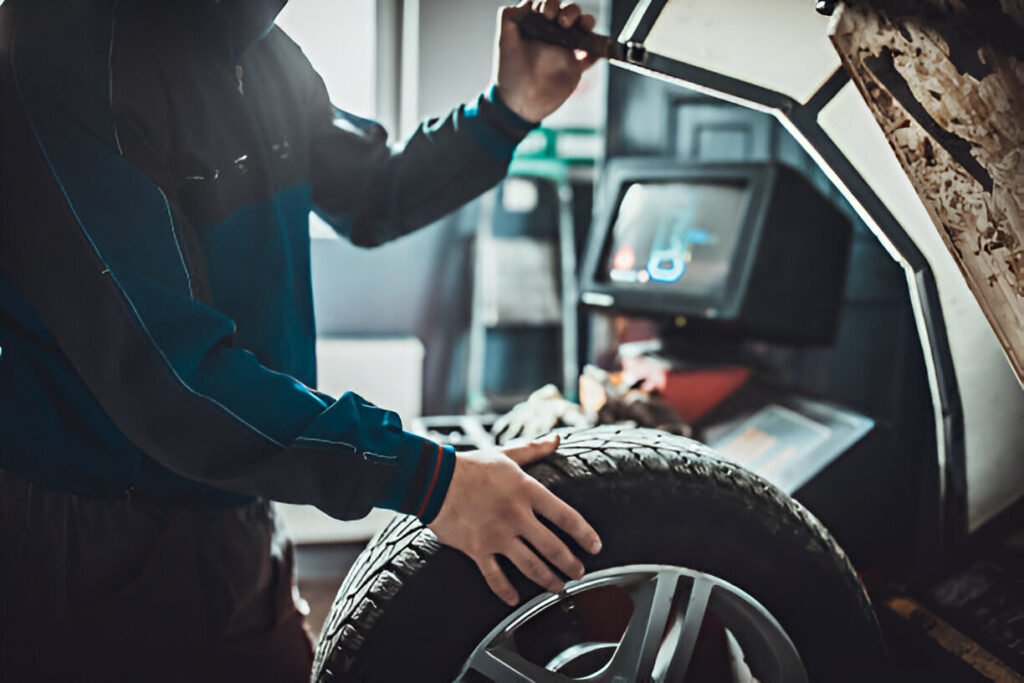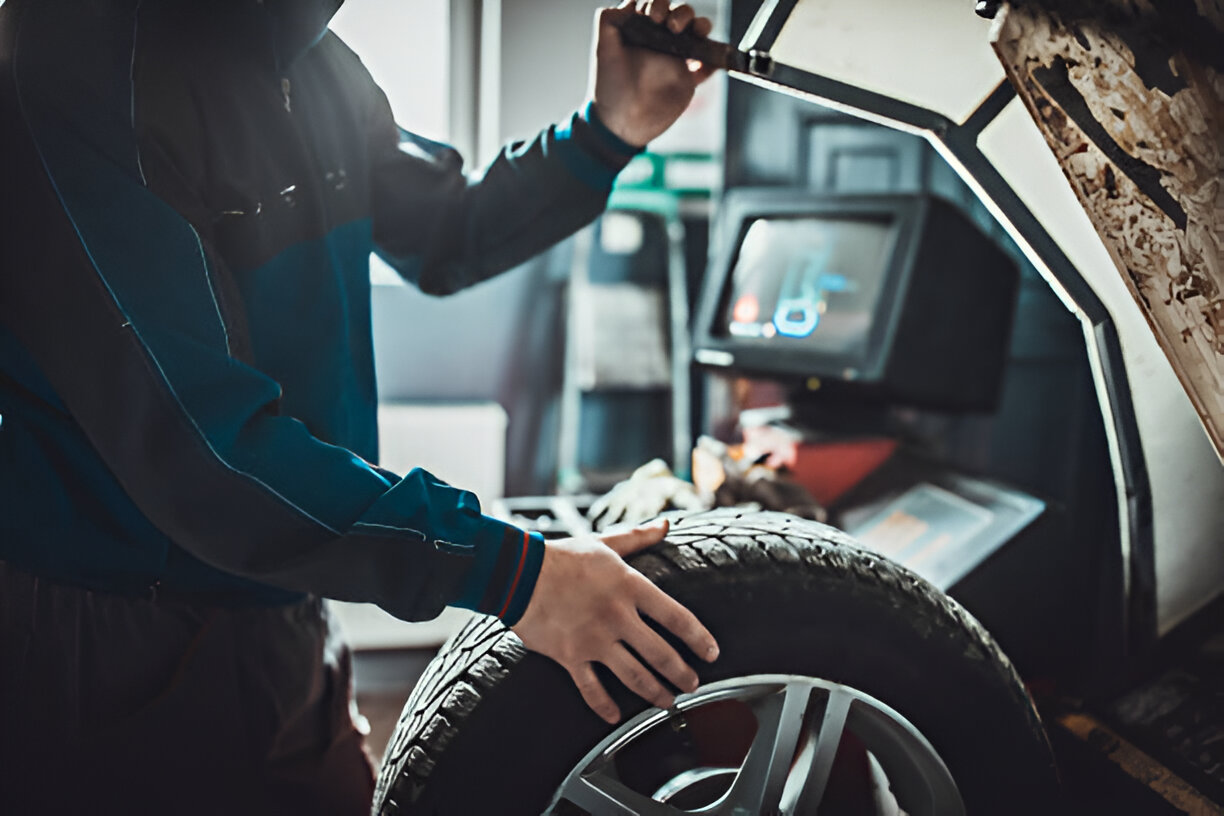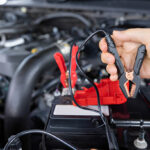Wheel alignment and wheel balancing are two different things, but equally important to ensure a comfortable ride. Understanding the differences between the two services helps you choose the right one for your car and eventually get more mileage out of your tires. It’s already a known fact that tires are the only part of the car that touch the road, so small setup errors show up quickly, such as pull, shake, or uneven wear, indicating that there might be a problem with your wheel balancing or alignment.
In this blog, you will learn about the key differences between wheel alignment vs balancing. Feel free to bookmark this blog as your go-to reference before you book service.
What Is Tire Balancing?
Tire balancing, also known as wheel balancing, addresses minor weight differences between the tire and wheel to ensure they rotate smoothly at high speeds. Since no two tires are exactly alike, normal driving can cause small changes over time. Hitting a pothole hard, brushing against a curb, or allowing the tires to sit for long periods can create flat spots or shift material within the tire. These slight changes can result in vibrations or shaking that you can feel while driving.
Balancing restores weight evenly around the wheels by placing clip-on or adhesive weights. A proper balance corrects both up and down hop and side-to-side wobble so the assembly spins flawlessly. When everything is even, the steering feels smoother, you stop hearing strange noises, and of course, your rides become smooth.
Wheel balancing also eases the load on shocks, bearings, and bushings, which helps them last longer. For very sensitive vehicles or low-profile tires, asking for a road force check and match mounting can further smooth out your drive.
What Happens During Tire Balancing?
A technician mounts each tire and wheel on a calibrated balancing machine and removes any old weights. The machine spins the assembly and measures where the heavy and light spots are. The readout shows the amount of correction needed and the exact positions for new weights on the inside and outside planes of the wheel.
Before the weights are installed, the tech checks air pressure, inspects the tread, and looks for rim bends or debris that could disturb the reading. The beads are properly seated, and the wheel face is cleaned so the weights adhere as they should. After the first correction, the assembly is spun again to confirm that the remaining imbalance is within a tight tolerance.
Balancing is often paired with a rotation or the installation of new tires. It is different from alignment. Alignment sets the angles of the wheels so the car tracks straight. Balancing smooths the spin so the car feels steady at speed.
What Are the Signs That Your Tires Need Balancing?
Look for a steering wheel that shakes at highway speeds, a seat that hums on smooth pavement, or a floorboard that tingles as you cruise. A vibration that comes and goes with speed is a classic sign. Also, uneven wear patterns, such as cupping or scalloping, also point to a balance issue.
The location of the vibration can indicate which axle may need attention. If you feel the shaking in the steering wheel, it is usually caused by the front tires. Conversely, if you sense the vibration in the seat, the rear tires are likely the problem. New tires should always be balanced when they are installed. Additionally, it’s a good idea to request balancing during routine rotations, after a flat tire repair, or anytime you hit a pothole hard enough to notice.
Extra tips from the bay:
- Keep the pressure set to the door placard before any balance check.
- Ask for a quick rim inspection if you hit a deep pothole or curb.
- Rebalance after any tire is dismounted for repair.
- Combine balance with rotation every five to six thousand miles to keep wear even.
Need help today? Visit A1st Auto Repair today. We will road test your car, check the assemblies, and send you off with a smoother ride.
What Is Wheel Alignment?
Wheel alignment, also called tire alignment, sets the steering and suspension angles so every wheel points in the right direction and meets the road at the right tilt. It does not change the tire itself. It ensures straight tracking, a centered steering wheel, and even tread wear. A correct wheel alignment improves stability in stops and turns. Additionally, it can also calm some on-road vibrations caused by uneven wear.
What Happens During Wheel Alignment?
At your local auto repair shop in Edison, the technician inspects the tires, checks the pressures, and examines the suspension joints. They attach measuring heads to assess the camber, caster, toe, and thrust angle based on the vehicle’s specifications. The technician begins by adjusting the rear angles to ensure the car follows a true thrust line.
Next, they adjust the front toe and camber to center the wheels and keep the car on a straight path. They make these adjustments using tie rods, cam bolts, or slotted mounts, and reset the steering angle sensor as needed. When you leave, you receive a printout that displays the before and after readings.
Tire wear can become uneven pretty fast if your alignment angles are off, so it’s a good idea to check your alignment after hitting a bump or before a long drive. If you notice your car shaking at certain speeds, consider getting your tires balanced, since misalignment can create uneven wear that leads to vibrations. Keeping your alignment in check helps protect your tires and makes your ride smoother on Edison roads. Understanding wheel alignment vs balancing helps you pick the right service and save you from forced upsells all the time.
Also read: 10 Signs Your Car Needs Immediate Auto Repair
Why Choose A1st Auto Repair in Edison, NJ
At A1st Auto Repair, you work with a local Edison team with more than three decades of experience. We take care of what your car needs in one stop, including engine and electrical diagnosis, brakes, steering and suspension, tires, wheel alignment, wheel balancing, A/C and heating, transmission services, preventive maintenance, and state vehicle inspection.
Every visit begins with a brief drive to assess the issue. We then conduct thorough tests and provide a written estimate. We use calibrated equipment and follow factory procedures to ensure that our repairs can withstand New Jersey road conditions.
Contact us now or visit our shop for a quote, and our auto repair technician will assist you after a quick assessment. If you are comparing services and need help deciding, we are happy to help you choose exactly what your car needs.
Get in touch with our team today to learn more about wheel alignment vs balancing.





